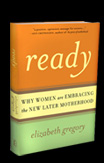Wishing everyone a year of true freedom, however you define it!
My own little “Exodus” story of going through divorce and infertility and coming out the other side inspired my dear friend the talented filmmaker Ilana Trachtman (of Praying with Lior fame) to make a little movie as part of the Projecting Freedom Project, sponsored by the Skirball Foundation. For this project, different filmmakers were commissioned to do a cinematic interpretation of a specific aspect of the Hagaddah. Here are Ilana’s, below (starring Marco, Anya, and Teo!)

 The Mommy Myth That Will Not Die: Bella Swan and Global Motherhood
The Mommy Myth That Will Not Die: Bella Swan and Global Motherhood
 One of the things I like most about blogging is that your subject can change as you do. This summer
One of the things I like most about blogging is that your subject can change as you do. This summer 





 If I could think of a topic that travels around the conversations of most women I know, the choice to have a child, and when, often lives pretty near the top of the list. Following it comes a litany of concerns: how to juggle career, partnerhood, personal and professional ambitions, and more.Â
If I could think of a topic that travels around the conversations of most women I know, the choice to have a child, and when, often lives pretty near the top of the list. Following it comes a litany of concerns: how to juggle career, partnerhood, personal and professional ambitions, and more.  PEACE.
PEACE. For Grandma Marge (may her memory be for a blessing)
For Grandma Marge (may her memory be for a blessing) It was recently pointed out to me by my dear observant friend
It was recently pointed out to me by my dear observant friend  These three researchy news items just in, courtesy
These three researchy news items just in, courtesy 